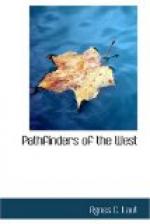The English court favored the project of trade in Hudson Bay, but during the Dutch war nothing could be done. The captain of the Dutch ship Caper had sent word of the French explorers to De Witt, the great statesman. De Witt despatched a spy from Picardy, France, one Eli Godefroy Touret, who chanced to know Groseillers, to meet the explorers in London. Masking as Groseillers’ nephew, Touret tried to bribe both men to join the Dutch. Failing this, he attempted to undermine their credit with the English by accusing Radisson and Groseillers of counterfeiting money; but the English court refused to be deceived, and Touret was imprisoned. Owing to the plague and the war, two years passed without the vague promises of the English court taking shape. Montague, the English ambassador to France, heard of the explorers’ feats, and wrote to Prince Rupert. Prince Rupert was a soldier of fortune, who could enter into the spirit of the explorers. He had fought on the losing side against Cromwell, and then taken to the high seas to replenish broken fortunes by piracy. The wealth of the beaver trade appealed to him. He gave all the influence of his prestige to the explorers’ plans. By the spring of 1668 money enough had been advanced to fit out two boats for Hudson Bay. In the Eagle, with Captain Stannard, went Radisson; in the Nonsuch, with Captain Zechariah Gillam of Boston, went Groseillers. North of Ireland furious gales drove the ships apart. Radisson’s vessel was damaged and driven back to London; but his year was not wasted. It is likely that the account of his first voyages was written while Groseillers was away.[5] Sometime during his stay in London he married Mary Kirke, a daughter of the Huguenot John Kirke, whose family had long ago gone from Boston and captured Quebec.
Gillam’s journal records that the Nonsuch left Gravesend the 3d of June, 1668, reached Resolution Island on August 4, and came to anchor at the south of James Bay on September 29.[6] It was here that Radisson had come overland five years before, when he thought that he discovered a river flowing from the direction of the St. Lawrence. The river was Nemisco. Groseillers called it Rupert in honor of his patron. A palisaded fort was at once built, and named King Charles after the English monarch. By December, the bay was locked in the deathly silence of northern frost. Snow fell till the air became darkened day after day, a ceaseless fall of muffling snow; the earth—as Gillam’s journal says—“seemed frozen to death.” Gillam attended to the fort, Groseillers to the trade. Dual command was bound to cause a clash. By April, 1669, the terrible cold had relaxed. The ice swept out of the river with a roar. Wild fowl came winging north in myriad flocks. By June the fort was sweltering in almost tropical heat. The Nonsuch hoisted anchor and sailed for England, loaded to the water-line with a cargo of furs.




